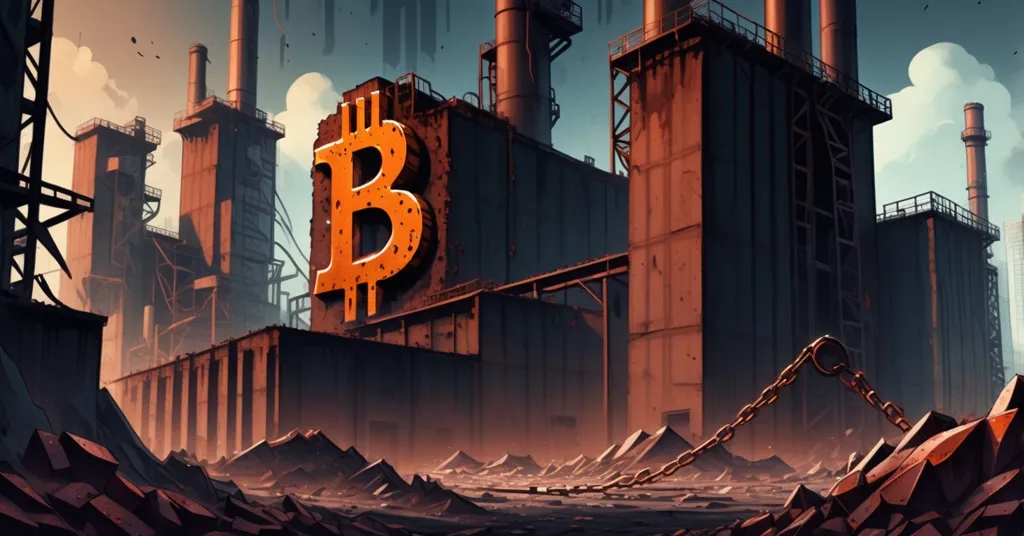Growler Mining Takes Over Argo Blockchain in $7.5M Debt-for-Equity Swap Crisis

Debt-for-Equity Swap: Growler Mining Seizes Control of Struggling Argo Blockchain
Argo Blockchain, once a titan in the crypto-mining realm, is now on life support as its primary lender, Growler Mining, takes the reins through a hard-hitting debt-for-equity swap. This move, under the banner of Project Triumph, is a desperate bid to save the company from insolvency while sounding a brutal alarm for the volatile world of Bitcoin mining.
- Massive Takeover: Growler Mining converts $7.5 million in loans into an 87.5% equity stake in Argo Blockchain.
- Stakeholder Wipeout: Existing shareholders are slashed to just 2.5%, with unsecured bondholders holding a mere 10%.
- Mining Collapse: Bitcoin output plummets from six coins per day in 2022 to two in 2024, crushed by outdated tech and soaring energy costs.
Financial Lifeline or Hostile Takeover?
Argo Blockchain’s story reads like a cautionary tale straight out of the wild west of crypto. Back in 2018, they made headlines as the first crypto company to go public on the London Stock Exchange, pulling in $32 million with a valuation of $61 million. That pioneering spirit positioned them as a bridge between blockchain tech and traditional finance. But fast forward to 2024, and Argo is teetering on the edge of oblivion, with cash reserves once dwindling to a pathetic $866,000—barely enough to cover a month’s worth of coffee for the team, let alone run energy-hungry mining rigs. Under the UK Companies Act, they’re now in a court-supervised restructuring to dodge complete collapse.
The core of this rescue—or takeover, depending on your perspective—is Project Triumph. Growler Mining, Argo’s main secured lender, is swapping $7.5 million of debt for a whopping 87.5% equity stake, a move detailed in recent reports on the debt-for-equity deal with Argo Blockchain. For those not steeped in financial lingo, think of a debt-for-equity swap as trading a massive IOU for ownership of the house you owe money on—except the house here is a struggling miner on the brink. This leaves existing shareholders with a laughable 2.5% slice of the pie, while unsecured bondholders—creditors without collateral to back their loans—get a slightly less pathetic 10%. If you’re holding Argo stock or American Depositary Receipts (ADRs), it’s time to face the music: your investment’s been gutted.
“Unless the Plan Company [Argo] implements a restructuring of its balance sheet, the Plan Company will be unable to obtain the funding it needs and will be insolvent on both a cash flow basis and a balance sheet basis.”
That grim warning from Argo itself lays bare the stakes. Without this deal, they’re dead in the water, unable to fund operations or service debts. But let’s not pretend this is charity from Growler Mining—they’re not saving a damsel in distress; they’re claiming the castle for pennies on the dollar. The legal process is moving fast, with hearings at the High Court of Justice in London set for November 5, 2025, followed by stakeholder voting on November 28, and a final sanction hearing on December 8. If any creditor class—say, disgruntled bondholders—rejects Project Triumph, the whole plan could implode, potentially pushing Argo into a messier insolvency. Who’s likely to oppose? Unsecured noteholders, already facing massive losses, might balk at the scraps they’re offered, gambling on a better outcome in liquidation. It’s a high-stakes showdown, and not everyone’s walking away with chips.
Mining Output Collapse: A Perfect Storm
Dig into Argo’s operations, and the picture gets uglier. In 2022, they were mining nearly six Bitcoins a day—a respectable haul in the crypto game. By 2024, that’s nosedived to just two. Why the freefall? Two culprits stand out: outdated hardware and crippling energy costs. Crypto mining relies on specialized machines called ASIC miners to solve complex mathematical puzzles, earning Bitcoin as a reward. But Argo’s rigs are relics—think of them as driving a rusty minivan in a drag race against Ferraris. Older models burn way more power per puzzle solved compared to cutting-edge gear, making every Bitcoin mined a money-losing proposition when electricity bills hit $0.12 per kWh or more in some regions.
Then there’s the Bitcoin halving, a programmed event every four years (last one in April 2024) that slashes mining rewards in half to control Bitcoin’s supply. Post-halving, miners earn less for the same work, and if your setup’s already inefficient, you’re toast. Argo’s management didn’t adapt fast enough—whether through upgrading rigs or hedging energy costs—and now they’re paying the price. For context, industry estimates suggest efficient miners spend $30,000-$40,000 per Bitcoin in energy alone at current rates. With Argo’s old tech, they’re likely bleeding far more than that. It’s not just a stumble; it’s a faceplant.
Strategic Pivots and Delisting Drama
Operationally, Argo’s been forced to pivot. After offloading their Helios facility in Texas to Galaxy Digital—a crypto financial services firm—they’ve zeroed in on the Baie-Comeau site in Canada and hosting centers in Tennessee and Washington State. This shift signals a bet on the US market, but it hasn’t stopped the hemorrhaging. On the capital markets front, they’re kissing goodbye to a six-year run on the London Stock Exchange with a planned delisting, focusing instead on maintaining their Nasdaq listing. To meet Nasdaq’s requirements, a reverse stock split is slated by January 2026. If you’re new to the term, it’s like turning 10 shares worth $1 each into 1 share worth $10—same total value, just fewer shares, often a desperate bid to inflate per-share price and avoid getting kicked off the exchange. It’s a cosmetic fix, not a cure for what ails them.
Navigating the US market isn’t a walk in the park either. Regulatory headwinds are kicking up dust, with the SEC keeping a hawkish eye on crypto firms and state-level rules on energy usage squeezing miners. States like Texas have flirted with grid restrictions for high-energy operations, which could spell trouble for Argo’s hosting centers if policies tighten. Beyond the balance sheets, there’s a human toll—potential layoffs or site cuts could hit communities like Baie-Comeau hard, though hard data on job losses remains scarce. This isn’t just about numbers; it’s about livelihoods caught in the crossfire of a struggling industry.
Mining’s Brutal New Reality
Argo’s mess isn’t a solo act—it’s a symptom of a ruthless shakeout across the crypto-mining world. The post-2021 bull run saw miners expand like crazy, drunk on Bitcoin prices north of $60,000. Then the bear market hit, energy costs spiked, and halvings gutted rewards. Look at competitors like Marathon Digital or Riot Platforms—they’ve survived by scaling with renewable energy or securing dirt-cheap power deals. Argo? They missed the memo. The industry’s now a Darwinian battlefield, with only the most efficient or best-funded players standing tall. Take Core Scientific, which filed for bankruptcy in 2022 before restructuring—proof that second chances exist, but only for those who adapt.
Bitcoin’s 2024 halving slashed block rewards to 3.125 BTC, down from 6.25. For miners already underwater, that’s a death knell unless you’ve got hash rates (computing power) and energy costs in perfect sync. Argo’s hash rate decline—though exact figures aren’t public—likely mirrors their output drop, painting a stark contrast to rivals who’ve doubled down on next-gen rigs. This isn’t just about one company floundering; it’s a litmus test for whether crypto mining can mature into a sustainable pillar of decentralized finance.
Playing Devil’s Advocate: A Blueprint for Survival?
As Bitcoin maximalists, we at “Let’s Talk, Bitcoin” believe in the survival of the fittest—weak players failing is just the network pruning dead weight. Mining secures Bitcoin’s trustless system, and if Argo can’t hack it, so be it. Their survival matters only if it strengthens that foundation. But let’s flip the script for a moment. Could Project Triumph be a roadmap for other struggling miners? Bitfarms, for instance, weathered similar storms by diversifying into hydropower and cutting costs. If Argo uses this lifeline to pivot—say, chasing renewables or even repurposing rigs for AI computing, a growing trend among miners—they might claw back relevance. Jobs and infrastructure could be preserved, lessons learned for the ecosystem. Still, let’s not get misty-eyed—sympathy doesn’t fix balance sheets, and Argo’s track record of missteps doesn’t inspire confidence.
Another wrinkle: Growler Mining’s control raises questions about centralization. Bitcoin thrives on dispersed power, but when a single lender owns 87.5% of a miner, it’s a step away from the ethos we champion. Is this restructuring saving Argo or just trading one form of fragility for another? We’re all for disruption and effective accelerationism, but not at the cost of the decentralized principles that make Bitcoin revolutionary.
Future Outlook: Best Case vs. Worst Case
Peering into the crystal ball, Argo’s path splits in two. Best case? Project Triumph gets the green light in late 2025, stakeholders begrudgingly agree, and Argo reinvents itself—maybe tapping cheap Canadian hydropower at Baie-Comeau or upgrading to efficient rigs. A Nasdaq listing keeps investor interest alive, and they carve a niche in a leaner, greener mining landscape. Worst case? Creditors torpedo the plan, insolvency looms, and Argo’s assets get carved up in a fire sale. Even if they survive court, without operational overhaul, they’re just delaying the inevitable in a market that chews up laggards for breakfast. Either way, the road ahead is a grind, fraught with risks and ruthless economics.
Key Takeaways and Burning Questions
- What triggered Argo Blockchain’s financial crisis in 2024?
Argo’s on the brink of insolvency with cash reserves once at a dire $866,000, unable to fund operations or pay debts without Growler Mining’s debt-for-equity swap. - How are Argo’s shareholders and bondholders affected?
Shareholders are diluted to a pitiful 2.5% equity, unsecured bondholders get 10%, and both face huge losses unless a miraculous turnaround boosts value. - Why has Argo’s Bitcoin mining output crashed so badly?
Output dropped from six Bitcoins daily in 2022 to two in 2024, hammered by inefficient, outdated hardware and energy costs that make mining a losing bet. - Can Project Triumph save Argo Blockchain from collapse?
It’s a lifeline if courts and stakeholders approve in late 2025, but success rides on fixing operations and navigating brutal market conditions—no guarantees here. - What does Argo’s struggle reveal about crypto mining challenges?
It exposes an industry squeezed by post-halving economics, energy costs, and tech obsolescence, where only the efficient or well-funded stand a fighting chance. - Is Argo’s survival worth rooting for in the Bitcoin ecosystem?
Bitcoin’s ethos says let the weak fail, but a reinvented Argo could preserve infrastructure and lessons—though we won’t shed tears if they can’t cut it.
Argo Blockchain’s saga is a gut punch for anyone in the crypto space, from wide-eyed newbies to grizzled OGs. It’s a stark reminder that the journey to decentralized finance isn’t a victory lap—it’s a battlefield of innovation, risk, and relentless market forces. Whether Project Triumph sparks a comeback or just postpones a funeral, one truth holds: the crypto-mining game spares no one who can’t keep up. Argo’s fate isn’t just about one company—it’s a test of whether mining can evolve into a sustainable force for Bitcoin’s future. What do you reckon it’ll take to get there? Stick with us as we keep slicing through the hype and hard truths of this wild Bitcoin revolution.



